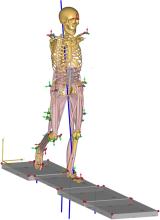Locomotion through the environment is important because movement provides access to key resources, including food, shelter and mates. Central to many locomotion-focused questions is the need to understand internal forces, particularly muscle forces and joint reactions. Musculoskeletal modelling, which typically harnesses the power of inverse dynamics, unites experimental data that are collected on living subjects with virtual models of their morphology. The inputs required for producing good musculoskeletal models include body geometry, muscle parameters, motion variables and ground reaction forces. This methodological approach is critically informed by both biological anthropology, with its focus on variation in human form and function, and mechanical engineering, with a focus on the application of Newtonian mechanics to current problems. Here, we demonstrate the application of a musculoskeletal modelling approach to human walking using the data of a single male subject. Furthermore, we discuss the decisions required to build the model, including how to customize the musculoskeletal model, and suggest cautions that both biological anthropologists and engineers who are interested in this topic should consider.
